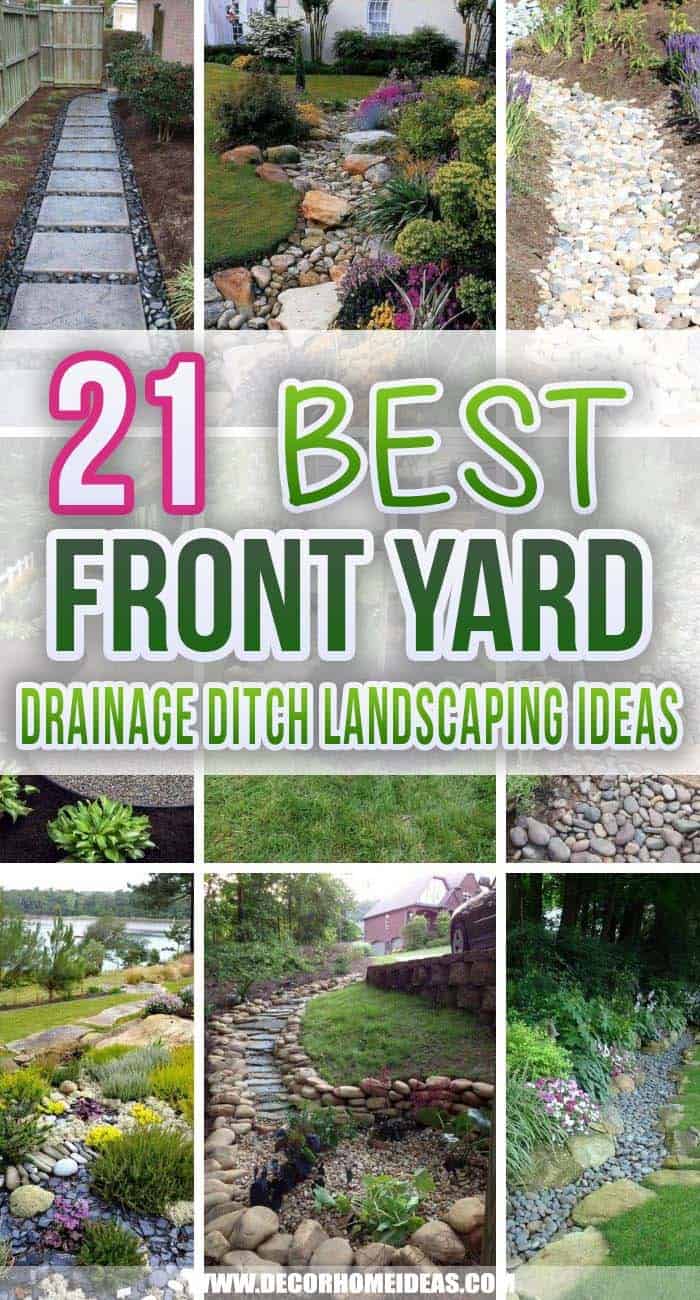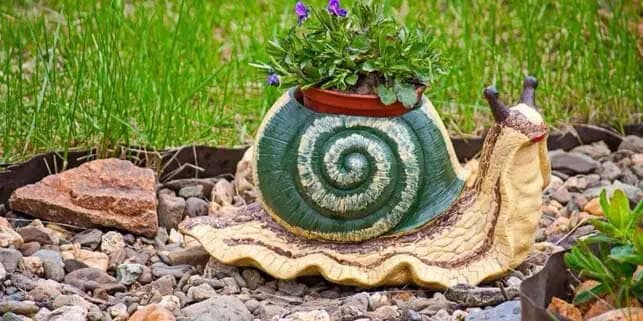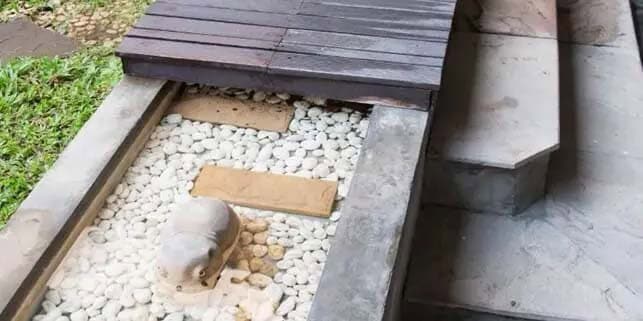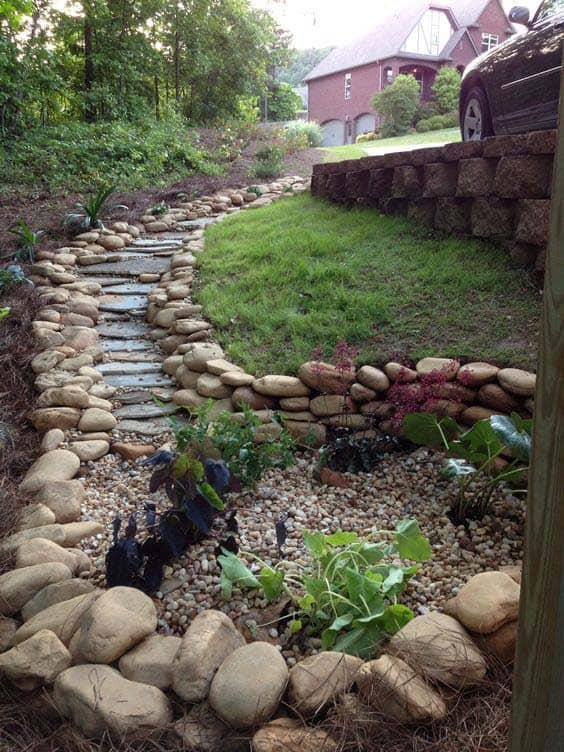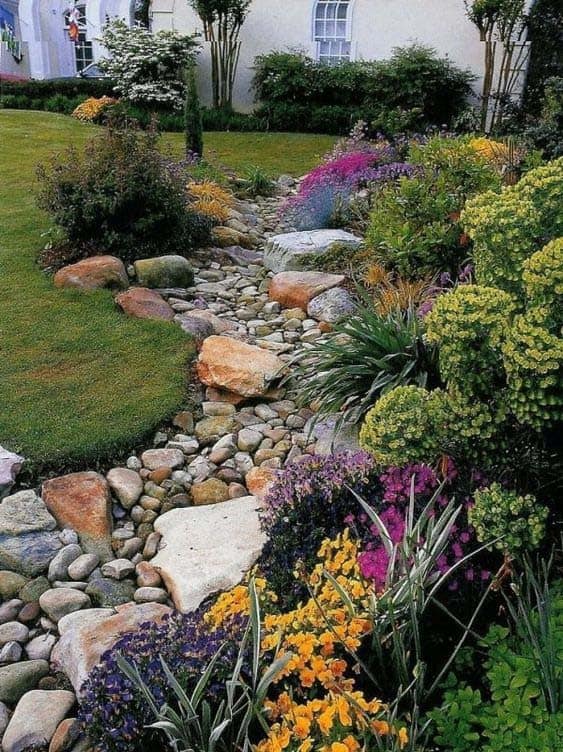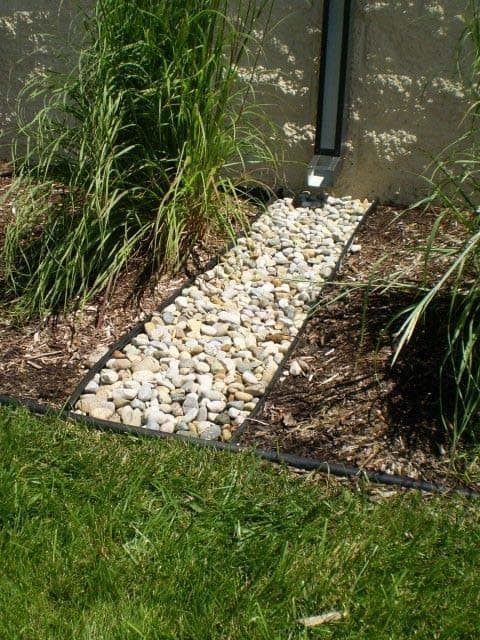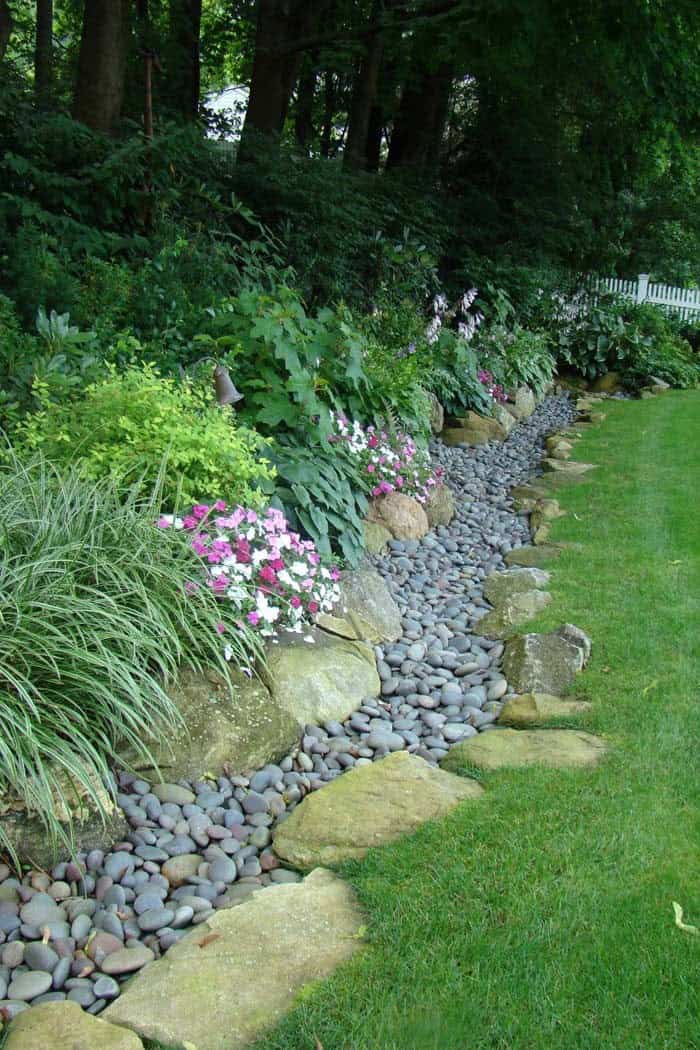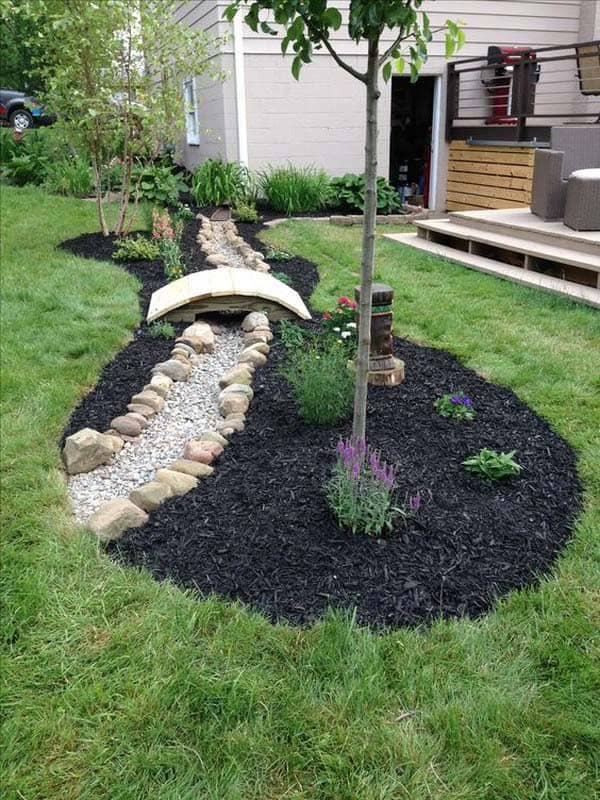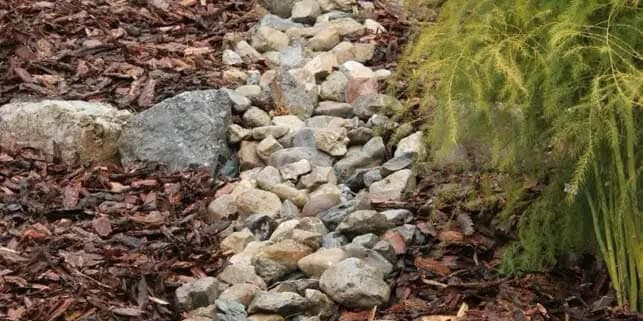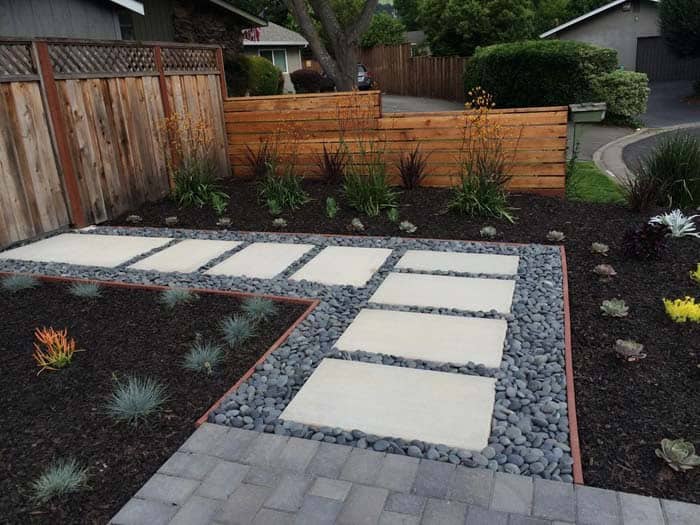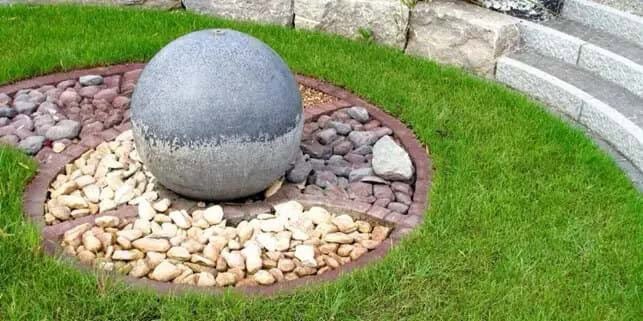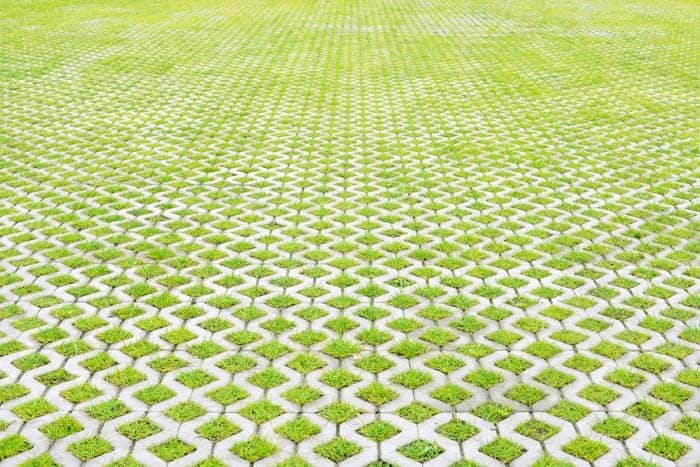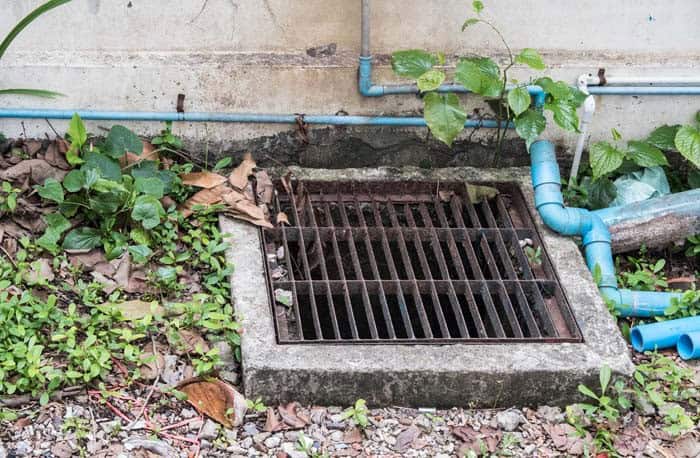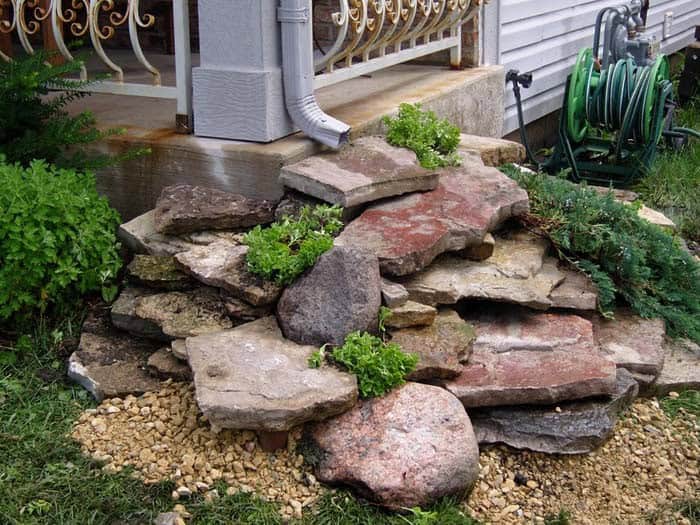Are you tired of dealing with a soggy front yard after heavy rainfall? If so, you’re not alone. Many homeowners struggle with managing excess water in their gardens, but there are cost-effective solutions that can help mitigate this issue without sacrificing the aesthetic appeal of your outdoor space.
One effective way to landscape around a drainage ditch is to utilize rocks and pebbles, which can be an inexpensive option.
Alternatively, you can use plants to conceal the drain or combine rocks with mulch for a visually appealing solution.
When it comes to planting near a drainage ditch, consider adding shrubs and hardy flowers to the highest areas surrounding the point of drainage. This will help prevent soil erosion and keep your yard looking its best.
Make a Statement with an Artistic Drainage Snail Planter
Transform your dry creek bed into a vibrant fantasy world by incorporating planters of various types. The addition of lush greenery brings visual interest, and the versatility of planters allows you to easily swap out designs or materials as needed. When selecting planters, consider opting for ceramic options instead of terracotta, as water can quickly deteriorate pots made from the latter material.
Improve Your Drainage with Stepping Stones
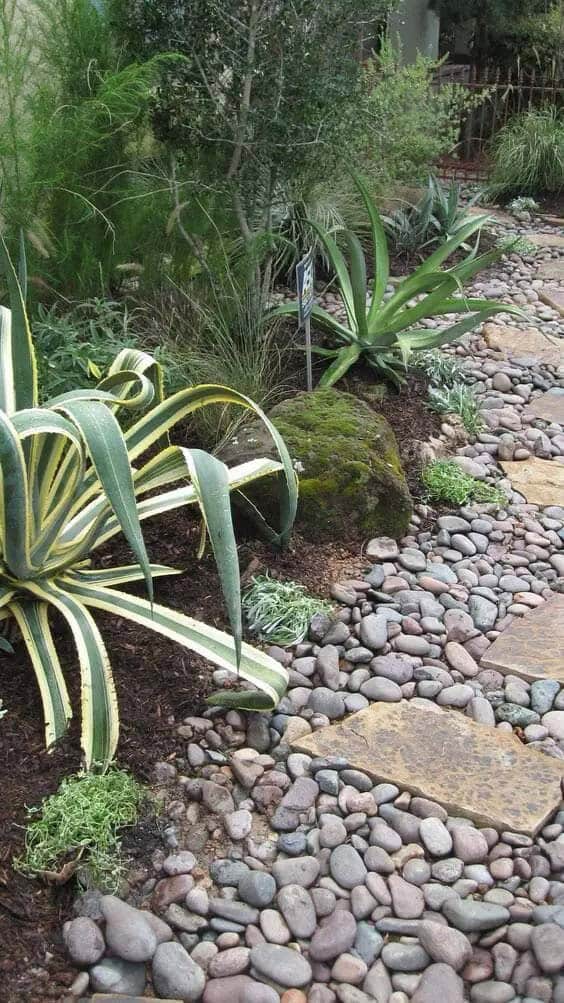
Transforming a once-barren dry creek bed or French drain into a visually appealing and functional feature is achievable by incorporating stepping stones. This innovative solution not only revitalizes the area but also provides a safe and non-slippery surface for walking. To achieve this, select natural-looking river rocks that harmonize with their surroundings in terms of color and texture, ensuring a cohesive look.
By doing so, you can breathe new life into an old ditch, making it a desirable spot to relax or entertain.
Create a Zen-Inspired Garden with Your Drainage System
By incorporating Japanese garden design principles into a landscape drainage system, you can create a harmonious and visually striking combination. Consider emphasizing symmetry, contrasting textures and colors, and incorporating natural materials like bamboo to achieve this effect. To recreate the look, you could use a footbridge, black lava rocks, white marble, and a bamboo water spout as focal points.
Additionally, sculptures such as meditation temples and intricately carved animals can also play important roles in completing the overall aesthetic.
Add Beauty and Utility to Your Property with Swales
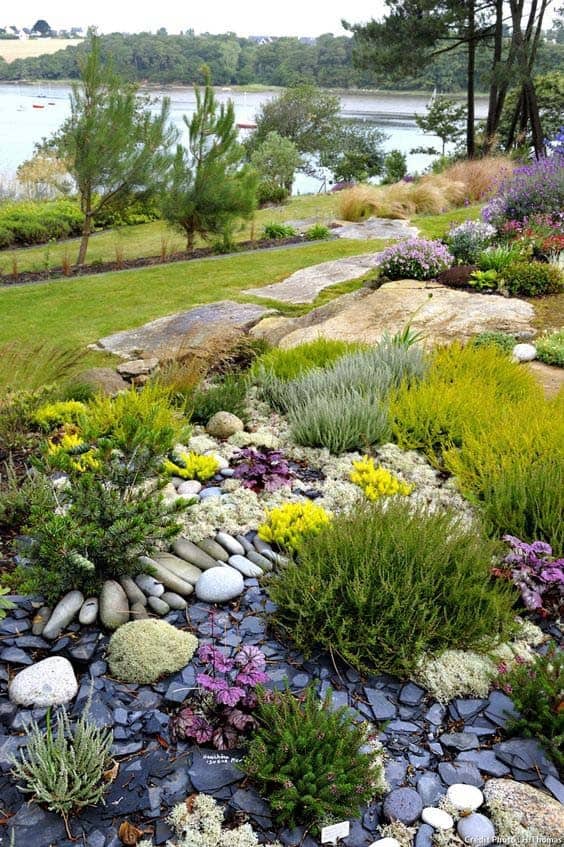
A swale offers an effective way to harness and utilize rainwater, unlike traditional drainage systems that simply redirect it away from the property. By incorporating plants and flowers along the path, the water is absorbed and utilized by the surrounding vegetation. To add visual appeal and functionality, the swale can be adorned with river rocks and boulders.
This eco-friendly solution proves particularly useful when redirecting rainwater off your property would create an issue for a neighbor or public property, minimizing potential conflicts.
Transform Your Drainage Ditch with a Stone Wall
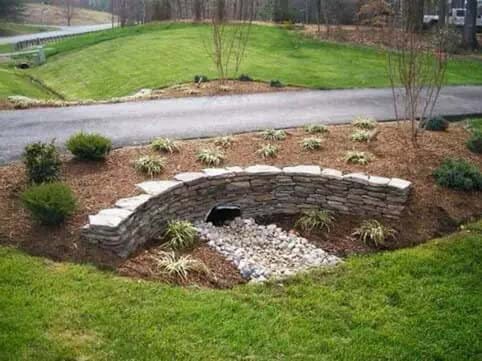
Underneath roads, drainage ditches can be vulnerable to water redirection, posing a threat to their integrity. A retaining wall installed alongside these ditches serves as a crucial barrier against erosion, which can compromise the road’s structural integrity. Meanwhile, the combination of mulch and Hosta plants plays a vital role in compacting the soil and stabilizing it near the drainage system, thereby preventing further erosion and damage.
Solve Your Drainage Problems with Rustic Stone Stairs
When it comes to constructing a ditch on a steep hill, traditional methods like using gravel may not be the most effective solution. Over time, the gravel can become dislodged and slide down to the bottom of the slope. A more practical approach is to utilize natural pavers and flagstone as stepping stones, which also serve as part of a retaining wall. This design allows for a harmonious blend of form and function.
To add an aesthetic touch, consider covering the base with pea gravel and incorporating water-loving plants. For added control over water drainage, consider installing a dry well at the base of the structure. A dry well can be thought of as a leaky bucket that collects and slowly releases excess water into the soil.
Protect Your Landscape with a Rock Drainage Channel
In the long term, adopting a harmonious approach can prove more cost-effective. The yard’s topography suggests that the majority of rainwater accumulates in one specific area. By introducing a creek bed, we’re able to harness this runoff and create a vibrant garden reminiscent of a swale. This innovative feature allows excess water to naturally drain away from the property, rather than pooling or flowing towards it.
Redirect Your Drainage Pipe Water with Elegant White Rocks
Prevent Waterlogged Gardens with Effective Drainage Solutions
Rethink your approach to downspouts: instead of letting them flood your garden bed, consider using rocks as a more effective drainage solution. Unlike mulch, rocks allow for better water flow and reduced saturation. To achieve this, dig a channel that intersects the bed and fill it with medium-sized rocks. When selecting edging, opt for plastic, which is ideal for redirecting water flow and ensuring your garden bed remains dry.
Create a Rustic Garden Edge with Dry Creek Bed
A common challenge many homeowners face is managing stormwater runoff in their yard, particularly when a nearby hill creates an issue with lawn maintenance. The solution lies in incorporating a dry creek bed into your landscape design. By placing this feature below the grade of your grass, you can effectively mitigate the problems associated with heavy rainfall.
The incorporation of river rocks within the ditch not only adds visual appeal to the area but also serves as a natural barrier that prevents water from pooling on the lawn and reduces erosion on the adjacent hill.
Design a Beautiful Garden Feature with a Drainage Ditch
Instead of concealing downspouts, consider showcasing them in your garden design. A creative example is transforming the drainage ditch into a visual feature by framing it with medium-sized rocks and filling it with gravel. This unique element can be seamlessly integrated into a garden bed adorned with water-loving plants. Trees are also known to utilize substantial amounts of water, effectively diverting runoff.
To replicate this look, you can easily source a footbridge and decorative lamp from most garden centers. For added versatility, swap the stones for bricks and incorporate edging to achieve a casual or formal ambiance. Additionally, lining the garden area will help retain the water within the designated space.
Enhance Your Curb Appeal with a River Rocks Ditch
Transforming a ditch into a visually appealing dry creek bed is a cost-effective landscaping solution that requires minimal effort. To achieve this look, start by incorporating eye-catching colors with native grasses and plants along the banks. When it comes to selecting stones for this project, you’re spoiled for choice at your local garden center or home improvement store.
From basic bedding rocks to smooth river rocks, white marble rocks, and multi-colored quartz, the options are endless – limited only by your budget.
Get Smart About Stormwater with Rocks and Mulch
When it comes to concealing a drainage ditch, striking the right balance between camouflage and visibility can be challenging. A clever approach is to surround the ditch with mulch, which not only helps to conceal its presence but also creates a visually appealing landscape feature.
In this example, large rocks are strategically placed to indicate the location of the drain while still blending seamlessly into the surrounding environment, creating a natural-looking solution that effectively hides the ditch without sacrificing functionality.
Add Splendour to Your Home with a French Drain
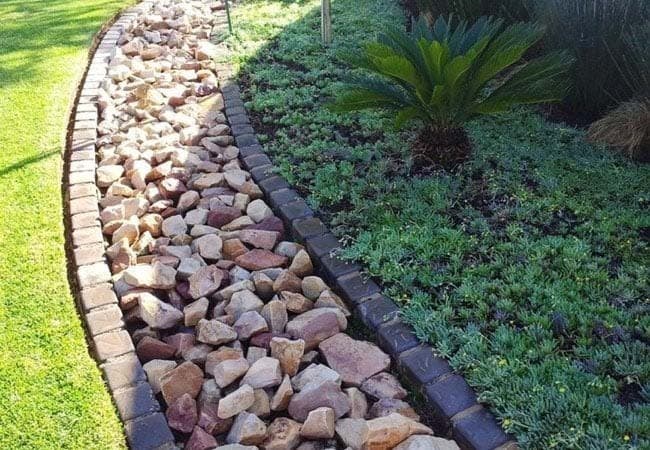
When faced with a persistent water issue in your yard, such as a ditch or excessive standing water after rainfall, a French drain can be an effective solution to alleviate the problem. This drainage system involves creating a graded trench and lining it with a filter cloth. The channel is then filled with pea gravel that surrounds a permeable drain pipe, topped with filter cloth and river stones.
End Your Soggy Landscaping Problems Pea Gravel
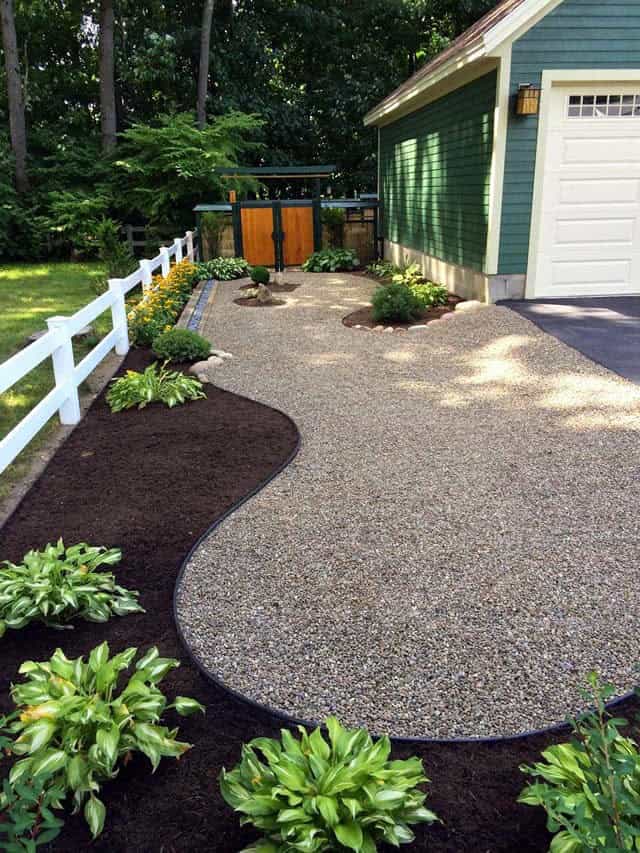
When faced with a challenging slope on one side of the house, conventional landscaping techniques would be rendered ineffective by the rain runoff from the driveway. To overcome this hurdle, pea gravel was used to redirect the water flow towards the back of the property, where it was then guided away from the home via a French drain.
Meanwhile, the perimeter of the landscape features a striking display of calla lilies thriving in the dark mulch, which not only adds visual appeal but also helps to stabilize the soil.
Build a Modern Landscape with Stepping Stones and Pebbles
When designing a pathway that manages stormwater runoff, consider incorporating a gravel-lined route to minimize rain accumulation on the steps. This can be achieved by creating a path at least two inches deep and layering it with a weed barrier, followed by medium-sized rocks and finally topped with weather-resistant pavers featuring an anti-slip surface. The gravel effectively accelerates drainage, reducing the likelihood of puddles forming on the pathway during or after rainfall.
Keep Your Home Dry and Beautiful
Water features can transform an undesirable waterlogged area into a beautiful focal point. Not only do they regulate the flow of runoff, but they also offer the perfect setting for a visually appealing fountain. This DIY project utilized materials readily available at your local home improvement store. The construction involved carefully cutting red brick to size and arranging rocks by color. The pièce de résistance is the addition of a pump, which brings the entire feature to life.
Reduce Flood Risk with Permeable Pavers
Landscapers and contractors frequently turn to permeable pavers as their go-to solution for creating functional and eco-friendly outdoor spaces. When it comes to driveways that experience frequent flooding, particularly after heavy rainfall, these pavers prove to be a game-changer. Unlike traditional cement or asphalt, permeable pavers enable water to penetrate the soil beneath, eliminating the need for costly drainage systems and reducing the risk of erosion.
As a result, they’re an attractive option for homeowners seeking a more sustainable and low-maintenance solution for their outdoor spaces.
Bring an Industrial Vibe with Commercial Drainage Grates
When it comes to commercial grates, you’ll find that they often come in two primary forms: straightforward covers and channel trenches. This design approach can be particularly effective when dealing with driveways or pathways that experience poor drainage issues due to their even elevation with the surrounding yard.
Get Creative with a Rock Drainage Fountain
As homeowners, we all have to contend with stormwater runoff from our downspouts. When your downspout is elevated, you can elevate the aesthetic appeal of your landscape by incorporating flagstone and creating a captivating water feature. For instance, consider building a fountain using layers of flagstone, carefully leveling each layer with dirt before securing large rocks in place to prevent shifting. The water’s final destination can be a visually pleasing crushed gravel.
Bring Sophistication to Your Home with Rock Landscaping
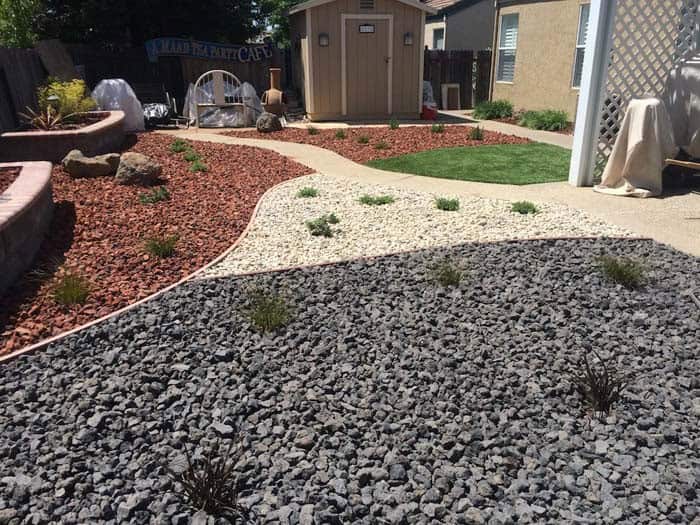
While rock gardens are often associated with hot and dry climates, they can be created in any environment. One of the benefits of a rock garden is that it can help alleviate issues with stormwater collection in your yard after heavy rainfall. By incorporating rocks and other hardscaping elements into your landscape design, you can create a beautiful and functional space that also helps to mitigate drainage problems.
Hide Your Drainage Ditch with Plants
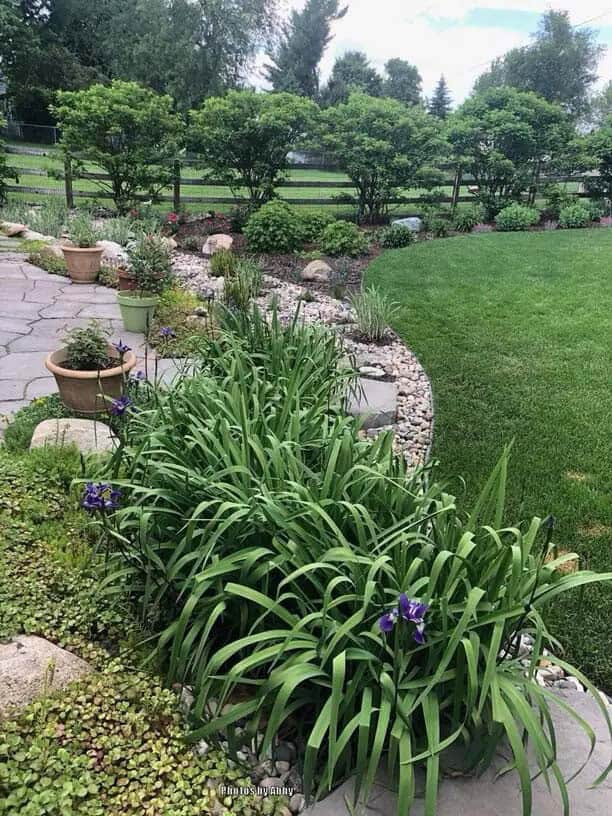
Transform your drainage area into a thriving oasis by incorporating rocks and water-loving plants. For optimal results, choose species that require a significant amount of water. Notable examples include irises, butterfly weeds, and daylilies, which will flourish in these conditions. Additional options like cattail, bee balm, and elephant’s ears can also thrive in this environment.
